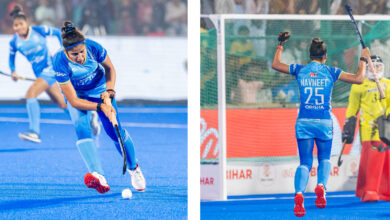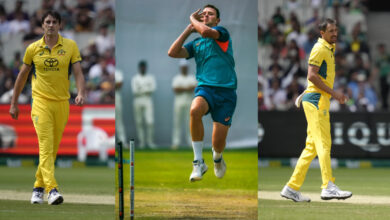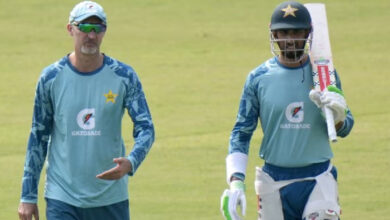View, Review: Is India blundering leaving out Saina from CWG?

Clarity would be a very fine thing to grasp, on where Saina Nehwal stands internationally right now. Her rankings are in free-fall even with the glacially moving, frozen, Covid-stunned standings in badminton. And slated to get worse on the back of two full wretched seasons and three lousy years of poor performance.
But you would have to be an utter badminton ignoramus to believe 100 percent the current crop of players on view at the recent trials, stand a better chance on the international stage, than her in the next few months. There’s fairness that trials cater to, keeping it all non-controversial and kosher. And there’s realism – a cold, clinical assessment of who can bring medals, which is the KRA that these Games ought to be about.
Saina hangs onto the tactical googly of a mid-set she nicked off World champion Akane Yamaguchi at the All England, a title which the Japanese won. But even she would know that the Badminton Asian Championships this coming week – preparing for which she skipped the national trials for Uber Cup, CWG and Asiad – will be followed closely to determine if she still has it in her, alongside her results in other pro circuit tournaments, where the international top names converge.
As things stand, Saina Nehwal is not headed to the Uber Cup and CWG, but good results on the Tour can put BAI in a quandary regarding the Asian Games, should they happen in September. Fitness permitting, Saina Nehwal you’d reckon, stands a higher chance of a CWG second medal behind Sindhu’s expected gold, than any of those that played in the trials this week. But her fitness is a big IF. So in sticking to transparency and “process”, worried about players going to court, India has left shrewdness aside, and gone and announced the squad way early.
Saina has 2 CWG titles from 2010 and 2018 (stunning, given Sindhu is yet to win that gold), a bronze from Asiad and Olympics, and a silver & bronze from the World’s, as well as an Uber Cup bronze. That’s the full set (possible), though some silvers and bronzes will be wful reminders of ‘could’ve been gold’s.’
One can safely say Saina Nehwal maxed her talent, over-achieved even, given her modest body-frame agility and court speed, on the basis of her sheer grit. So this is not about completing her legacy, but eking a medal out of the second Indian sent to Birmingham, given the very average competition in CWG.
At this stage of her career and with her body wracked injuries at age 33, any notable win will be a bonus and it will be miraculous if she gets into any of the top tournament final Sundays. That, she is keen to not go out of the game gently and allow the inevitabile fading of the light, and fancies a few lashing scythes at beating the top names, an upset here, a string of 4 wins there, is her stubborn Saina personality.
But a little like Mary Kom in boxing, questions remain dangling on whether she is stretching this out to indulge her own testing of longevity or if she’s actually good enough to sneak in even that stray title. In the next few months, you will know.
She’s copped a loss against Malvika Bansod at the India Open, and doesn’t carry that aura of invincibility which pugils set a lot of store . But Bansod couldn’t make the Top 4 of the selection trials, and Aakarshi Kashyap who heads for the Commonwealth Games, will be expected to match India’s 2018 count of gold & silver in women’s singles alongwith PV Sindhu. The CW Games are no place for ‘exposure’ in a sport like badminton, with just one-third of the top nations present, with expectations from heavily-funded Indians being to go for the top podiums. Target – gold + silver in Women’s singles + pulling out wins in team event.
The politics on withdrawing funding from Saina Nehwal and if she deserves it at all, can keep churning forever. But the question will always be if India is forsaking a second medal, to teach Nehwal a lesson about conforming to BAI and SAI’s stated rules.
The selection criterion ought to always be ‘Who can bring home a medal?’ from these Games especially in a high-achieving and peak precedent sport like badminton. Never mind how thorough and meticulous the recently concluded domestic trials were.
And given Saina has been left out – since she didn’t take the trials and the federation had no choice – Aakarshi will be expected to step up and go the dance, contend for a medal. Or leave the question hanging – could Saina Nehwal have made a game out of this for that place on the podium?
Contesting for the big medals, for a place on the podium – not less, and not merely making up numbers, can be called the greatest legacy of PV Sindhu and Saina Nehwal at shuttle’s biggest competition stages since the time they were airdropped into international arenas. The duo went prepared for the biggies, like athletes from champion nations do – to win, or fight trying. Hitting the ground running, and noone made excuses about them taking time to settle in, such was their readiness.
More pointedly, when they were coming up at 16 or 17, the two already had the domineering aura on the domestic circuit that the likes of Aakarshi, Ashmita, Malvika, all 20+ just cannot boast of. The current bunch loses frequently to each other, and is some paces off winning Super 300 level competitions even. Nehwal won Philippines at 17.
Settling for middling finishes, dawdling in juniors longer than needed, lingering over exposure trips in early 20s and waiting for seasons on end, refitting the wheel, hoping to claw from Top 60 to Top 50 to Top 40 to Top 30 instead of the really rapid Top 15 that Saina and Sindhu made, is a slow, invisible path to underwhelming careers in a sport that’s shown India dizzy possibilities. Yes, someone has to make up the Top 20 and 30s in the world, but it needn’t be a bunch of stagnant Indians!
Coach Vimal Kumar recently spoke of a lack of a finishing kill stroke and prevalence of unending rallying amongst the new bunch of young players now lining up behind Sindhu and Saina. As trained eyes do, he senses the immediate absence of that one special metric – a smash weapon, aerial deception, speed and accuracy like a compulsive rallys like Nozomi Okuhara, a solitary smash like Lakshya Sen had at 16, something, anything that nail for you those wins. Not mere promise.
Age 21 would be a tad too late for this realisation to hit to start forging a stinging smash-kill and grow an attacking weapon. Sindhu and Saina arrived on the international scene, ready with their attacking sabres which set them apart. Coach Pullela Gopichand prepped them at the outset to make the giant leaps and score the early upsets.
Those like Ashmita Chaliha, Tasneem Mir, Tara Shah, Unnati Hooda and now Anupama Upadhyay have the attacking chops. ‘Little Saina’ Unnati Hooda boasts of a ‘will beat anyone’ attitude too as well as the strength. Tosses from her backhand corner can travel to the opposite baseline, so power isn’t missing. Yet the transition from promise to international wins is the toughest process, something the moneybags – sponsors and official funders, don’t give much thought to beyond negotiating contracts with a foreign coach. The process is more complicated than signing cheques and should be left to the experts like Padukone, Vimal Kumar and Pullela Gopichand who oversaw these transitions.
Extrapolating domestic success to equate international win projections is just the sort of naive assumptions that those signing cheques make. Remember, 10 Indians in Top 40 can’t be the target of a country if none of them goes deep into tournament finals pushing for Top 10.
But even as Indian badminton puts into place a system of pushing 10 women into the Top 40 and then hoping one of them clicks and goes forward, it’ll have to ins on not settling for the Top 30 dawdlers and continuously demand excellence, the sort that Saina or Sindhu delivered on.
Both China and Thailand push numbers hoping for probability to kick in, but China succeeds more in raking in the crucial medals because their youngsters come prepared for a sudden blitz. So a well organised domestic trial is no direct entry-way to guiding a Top Tenner. It helps data crunchers, but can’t replace a coach’s keen eye.
There’s three ways to look at the CWG selection: one, fairness was followed. With her drastically improved fitness, Aakarshi’s game is up several notches from a year ago, and she’s a driven individual who will need mentors to set her highest goals, and not settle.
Two, if 2024 Paris and LA 2028 Games was the target, then Unnati Hooda would be a better pick. Remember, Saina cracked a crucial CWG team match at 15. With a smash to boot.
Three, the big picture can often cloud immediate clarity. India needs to retain the gold and silver from 2018 Commonwealth Games – the wise men and women need to honestly answer if Aakarshi Kashyap stands a better chance than Saina Nehwal, if the latter says she’s fit enough.







